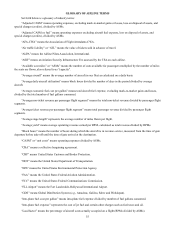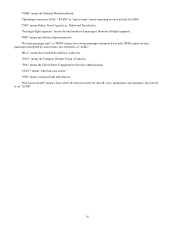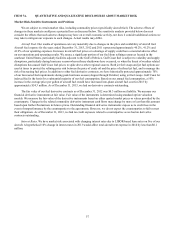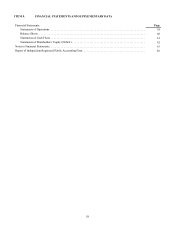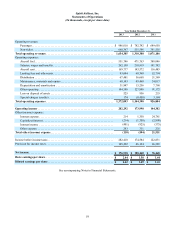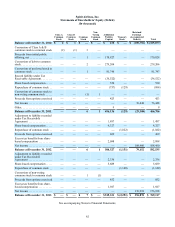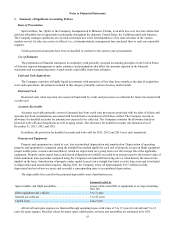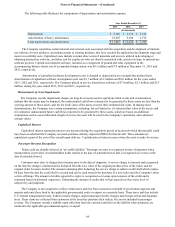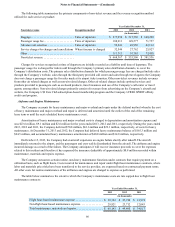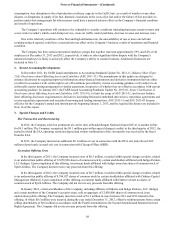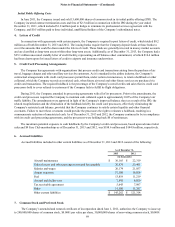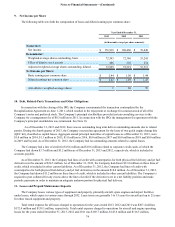Spirit Airlines 2013 Annual Report Download - page 65
Download and view the complete annual report
Please find page 65 of the 2013 Spirit Airlines annual report below. You can navigate through the pages in the report by either clicking on the pages listed below, or by using the keyword search tool below to find specific information within the annual report.
Notes to Financial Statements—(Continued)
65
Frequent Flier Program
Flown Miles. The Company records a liability for mileage credits earned by passengers under its FREE SPIRIT program,
including mileage credits for members with an insufficient number of mileage credits to earn an award, based on the estimated
incremental cost of providing free travel for credits that are expected to be redeemed. Incremental costs include fuel, insurance,
security, ticketing and facility charges reduced by an estimate of fees required to be paid by the passenger when redeeming the
award.
Affinity Card Program. Under the Company's affinity card program, funds received for the marketing of a co-branded
Spirit credit card and delivery of award miles are accounted for as a mulitple-deliverable arrangement. At the inception of the
arrangement, the Company evaluated all deliverables in the arrangement to determine whether they represent separate units of
accounting using the criteria as set forth in ASU No. 2009-13. The Company determined the arrangement had three separate
units of accounting: (i) travel miles to be awarded, (ii) licensing of brand and access to member lists and (iii) advertising and
marketing efforts. Under ASU No. 2009-13, arrangement consideration was allocated based on relative selling price. At
inception of the arrangement, the Company established the relative selling price for all deliverables that qualified for
separation. The manner in which the selling price was established was based on a hierarchy of evidence that the Company
considered. Total arrangement consideration was then allocated to each deliverable on the basis of the deliverable’s relative
selling price. In considering the hierarchy of evidence under ASU No. 2009-13, the Company first determined whether vendor
specific objective evidence of selling price or third-party evidence of selling price existed. It was determined by the Company
that neither vendor specific objective evidence of selling price nor third-party evidence existed due to the uniqueness of the
Company’s program. As such, the Company developed its best estimate of the selling price for all deliverables. For the award
miles, the Company considered a number of entity-specific factors when developing the best estimate of the selling price
including the number of miles needed to redeem an award, average fare of comparable segments, breakage, restrictions and
other charges. For licensing of brand and access to member lists, the Company considered both market-specific factors and
entity-specific factors including general profit margins realized in the marketplace/industry, brand power, market royalty rates
and size of customer base. For the advertising element, the Company considered market-specific factors and entity-specific
factors, including the Company’s internal costs (and fluctuations of costs) of providing services, volume of marketing efforts
and overall advertising plan. Consideration allocated based on the relative selling price to both brand licensing and advertising
elements is recognized as revenue when earned and recorded in non-ticket revenue. Consideration allocated to award miles is
deferred and recognized ratably as passenger revenue over the estimated period the transportation is expected to be provided
which is estimated at 16 months. The Company used entity-specific assumptions coupled with the various judgments necessary
to determine the selling price of a deliverable in accordance with the required selling price hierarchy. Changes in these
assumptions could result in changes in the estimated selling prices. Determining the frequency to reassess selling price for
individual deliverables requires significant judgment. As of December 31, 2013, there have been no changes in either the
selling price or the method or assumptions used to determine selling price for any of the identified units of accounting that
would have a significant effect on the allocation of consideration.
The following table illustrates total cash proceeds received from the sale of mileage credits and the portion of such
proceeds recognized in revenue immediately as marketing component:
Cash proceeds from
sale of miles to non-airline
third parties
Portion of proceeds
recognized immediately as
marketing component
Year Ended (in thousands)
December 31, 2013 . . . . . . . . . . . . . . . . . $ 28,496 $ 23,124
December 31, 2012 . . . . . . . . . . . . . . . . . 24,938 20,998
December 31, 2011 . . . . . . . . . . . . . . . . . 20,954 16,580
The total liability for future FREE SPIRIT award redemptions and unrecognized revenue from the sale of mileage credits
was $2.6 million and $2.4 million at December 31, 2013 and 2012, respectively. These balances are recorded as a component of
air traffic liability in the accompanying balance sheets.
Non-ticket Revenue Recognition
Non-ticket revenues are generated from air travel-related services for baggage, bookings through the Company’s call
center or third-party vendors, advance seat selection, itinerary changes and loyalty programs. Non-ticket revenues also consist
of services not directly related to providing transportation such as the FREE SPIRIT affinity credit card program, $9 Fare Club
and the sale of advertising to third parties on Spirit’s website and on board aircraft.


